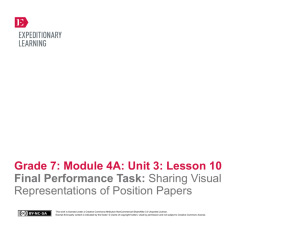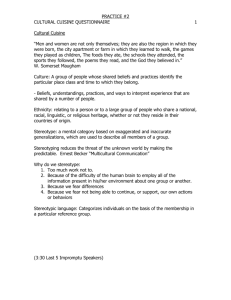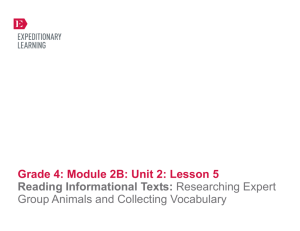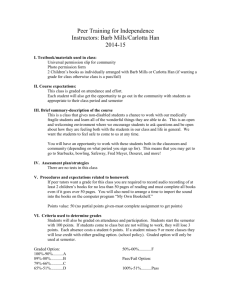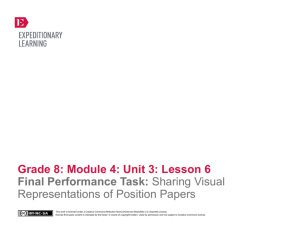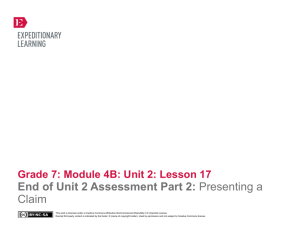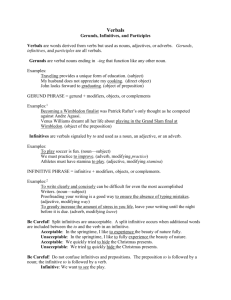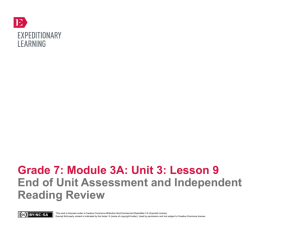Grade 8: Module 3B: Unit 3: Lesson 1 Analyzing a Central Idea
advertisement
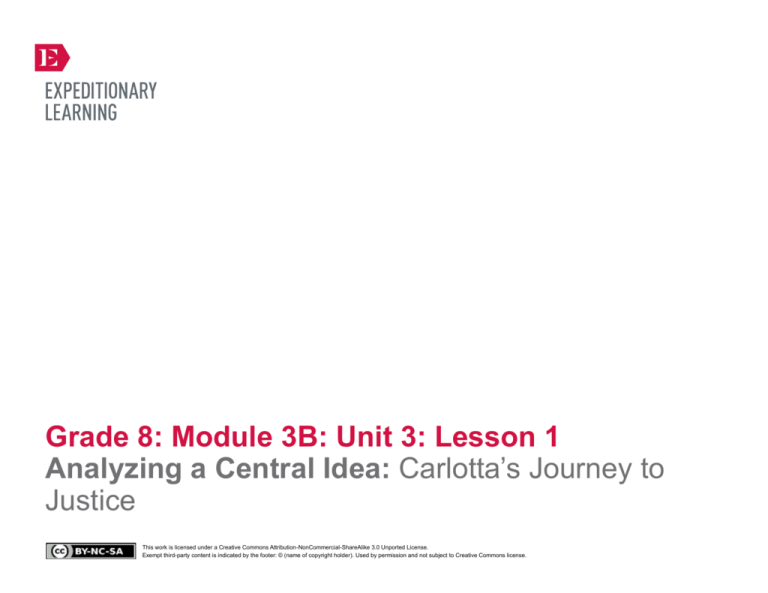
Grade 8: Module 3B: Unit 3: Lesson 1 Analyzing a Central Idea: Carlotta’s Journey to Justice This work is licensed under a Creative Commons Attribution-NonCommercial-ShareAlike 3.0 Unported License. Exempt third-party content is indicated by the footer: © (name of copyright holder). Used by permission and not subject to Creative Commons license. GRADE 8: MODULE 3B: UNIT 3: LESSON 1 Analyzing a Central Idea: Carlotta’s Journey to Justice Long-Term Targets Addressed (Based on NYSP12 ELA CCLS) I can use correct grammar and usage when writing or speaking. (L.8.1) I can explain the function of verbals (gerunds, participles, infinitives) in general and their function in particular sentences. (L.8.1a) I can recognize and correct inappropriate shifts in verb voice and mood. (L.8.1d) I can analyze the development of an idea throughout the text (including its relationship to supporting ideas). (RI.8.2) I can analyze how specific dialogue or incidents in a plot propel the action, reveal aspects of a character, or provoke a decision. (RL.8.3) I can analyze figurative language, word relationships, and nuances in word meanings. (L.8.5) Supporting Learning Targets Ongoing Assessment • I can use correct grammar and usage when writing. • A Mighty Long Way Structured Notes, Chapter 17, Pages 265–274 (from homework) • I can explain the general function of verbals (gerunds, participles, infinitives) and their function in sentences. • I can recognize and correct inappropriate shifts in verb voice and mood. • Verbals handout • Exit ticket: Verbals • I can analyze a central idea in A Mighty Long Way. • I can analyze how an incident described in A Mighty Long Way provokes Carlotta to make a decision. Created by Expeditionary Learning, on behalf of Public Consulting Group, Inc. © Public Consulting Group, Inc., with a perpetual license granted to Expeditionary Learning Outward Bound, Inc. NYS Common Core ELA Curriculum • G8:M3B:U3:L1 • June 2014 • 1 GRADE 8: MODULE 3B: UNIT 3: LESSON 1 Analyzing a Central Idea: Carlotta’s Journey to Justice Agenda Teaching Notes 1. Opening • In the Opening of this lesson, students learn about verbals: gerunds, participles, and infinitives. This Opening is the second of a three-lesson series in which students focus on language skills during the Opening. The series is designed to prepare students for the mid-unit assessment in Lesson 3, which will test their ability to identify active and passive voices, identify conditional and subjunctive moods, and analyze word meanings and word choice. A. Engaging the Writer: Language Techniques (10 minutes) B. Reviewing the Learning Targets (1 minute) 2. Work Time A. Analyzing the Journey: “This Little Light of Mine” (29 minutes) 3. Closing and Assessment A. Exit Ticket: Verbals (5 minutes) 4. Homework A. Continue independent reading book. • Language standards require consistent practice and reinforcement. Based on the needs of your students, find additional opportunities to teach and practice these standards. Sample language mini lessons may be found in the supporting materials for Unit 2, Lesson 19. These mini lessons may be used for additional instruction or used as a model for additional teacher-created language mini lessons, based on students’ needs. • Students will continue to study the language standards as a way to better understand the author’s craft in telling her story. • In this lesson, students complete the Journey to Justice note-catcher with details from the remaining chapters of A Mighty Long Way text. This work will be done using a jigsaw design. • In advance: – Predetermine groups of four for the jigsaw activity in Work Time A. – Review: Jigsaw protocol (see Appendix). • Post: Learning targets Created by Expeditionary Learning, on behalf of Public Consulting Group, Inc. © Public Consulting Group, Inc., with a perpetual license granted to Expeditionary Learning Outward Bound, Inc. NYS Common Core ELA Curriculum • G8:M3B:U3:L1 • June 2014 • 2 GRADE 8: MODULE 3B: UNIT 3: LESSON 1 Analyzing a Central Idea: Carlotta’s Journey to Justice Lesson Vocabulary Materials gerund, participle, infinitive • Verbals handout (one per student) • Verbals handout (answers, for teacher reference) • A Mighty Long Way (book; one per student) • Journey to Justice note-catcher (begun in Unit 1, Lesson 3) • Declaration of Independence excerpt (from Unit 1, Lesson 1 Gallery Walk; one to display) • Document camera • Exit Ticket: Verbals (one per student) • Exit Ticket: Verbals (answers, for teacher reference) Created by Expeditionary Learning, on behalf of Public Consulting Group, Inc. © Public Consulting Group, Inc., with a perpetual license granted to Expeditionary Learning Outward Bound, Inc. NYS Common Core ELA Curriculum • G8:M3B:U3:L1 • June 2014 • 3 GRADE 8: MODULE 3B: UNIT 3: LESSON 1 Analyzing a Central Idea: Carlotta’s Journey to Justice Opening Meeting Students’ Needs A. Engaging the Writer: Language Techniques (10 minutes) • Consider having students circle the verbs on the handout and underline the verbals. • Ask students to sit with their Washington, D.C. discussion partners. • Distribute the Verbals handout. • Read the definition of verbals at the top of the page. Explain that authors can use verbals in a variety of ways in their writing to aid understanding. Explain that there are three types of verbals: gerunds, participles, and infinitives. • Cold call a student to read the definition and purpose of a gerund. • Cold call students to read the examples. Point out that gerunds look like verbs but act as nouns. • If necessary, remind students of the definition of a verb. Be sure students understand that a verb expresses a physical action, a mental action, or a state of being. • Cold call a student to read the definition and purpose of a participle. • Cold call students to read the examples. Point out that there are two types of participles: past and present. • Cold call a student to read the definition and purpose of an infinitive. • Point out that students have probably encountered infinitives in their foreign language studies. The infinitive in most foreign languages is a special form of the verb, but in English, an infinitive is the word “to” with the stem form of the verb. • Cold call a student to read the examples. • Read the tip on the handout aloud. Explain that it can be tricky as students encounter sentences with a verb and one or more verbals to accurately identify the verb and verbals. Encourage students to find the word acting as the verb in the sentence before trying to identify the verbals. • Invite students to work with their partners to practice identifying verbals in the example sentences from A Mighty Long Way on page 2 of the verbals handout. Circulate and monitor. • When students are done, go over the answers, referring to the Verbals handout (answers, for teacher reference) as needed. • Explain to students that studying the author’s craft and use of language techniques such as verbals will help them further analyze the text, which they began to study to study in the previous lesson. Created by Expeditionary Learning, on behalf of Public Consulting Group, Inc. © Public Consulting Group, Inc., with a perpetual license granted to Expeditionary Learning Outward Bound, Inc. NYS Common Core ELA Curriculum • G8:M3B:U3:L1 • June 2014 • 4 GRADE 8: MODULE 3B: UNIT 3: LESSON 1 Analyzing a Central Idea: Carlotta’s Journey to Justice Meeting Students’ Needs Opening (continued) B. Reviewing the Learning Targets (1 minute) • Direct students’ attention to the learning targets and read the last two learning targets aloud: * “I can analyze a central idea in A Mighty Long Way.” * “I can analyze how an incident described in A Mighty Long Way provokes Carlotta to make a decision.” • Cold call several students to summarize what they know about the central idea of finding one’s voice. Listen for students to use the terms “dignity” and “justice” in their responses. Work Time Meeting Students’ Needs A. Analyzing the Journey: “This Little Light of Mine” (29 minutes) • Note: The event in which Carlotta meets with Herbert and learns his story is a longer piece of text. • Place students in heterogeneous small groups of four for a Jigsaw protocol, asking them to each bring their own copy of A Mighty Long Way and the Journey to Justice note-catcher with them. • Display the Declaration of Independence excerpt under the document camera while students are moving into their groups. • Draw students’ attention to the third stage on the Journey to Justice note-catcher. • Read aloud the summary and questions related to the third stage on the Journey to Justice note-catcher as students read along silently in their heads: • Consider providing hint cards with details and/or probing questions to help direct students who struggle or isolating the text students will need to read on a separate document. * “Life gains a new level of integration after the intense trials and triumphs of the journey; but it’s not over. Obstacles still exist and one feels the need to give back and make the world more whole. At what point did Carlotta begin her new life after her experiences at Central High School? What were some of the obstacles Carlotta had to face as a result of her experiences? In what ways did she begin to give back and help make the world better for others?” • Point out to students that although Carlotta might not have realized it, her conviction and determination to play a role in the integration of schools when she was a teenager was due to her belief in the founding document of this country, the Declaration of Independence. Created by Expeditionary Learning, on behalf of Public Consulting Group, Inc. © Public Consulting Group, Inc., with a perpetual license granted to Expeditionary Learning Outward Bound, Inc. NYS Common Core ELA Curriculum • G8:M3B:U3:L1 • June 2014 • 5 GRADE 8: MODULE 3B: UNIT 3: LESSON 1 Analyzing a Central Idea: Carlotta’s Journey to Justice Meeting Students’ Needs Work Time (continued) • Share with students some key basic background knowledge about the Declaration of Independence: it was written in 1776, almost two centuries before Carlotta’s journey to justice in Little Rock. Its most famous and enduring lines are, “We hold these truths to be self-evident, that all men are created equal, that they are endowed by their Creator with certain unalienable rights, that among these are Life, Liberty, and the pursuit of Happiness.” • Ask students: * “What basic American value does Jefferson express in these very famous lines?” * “How has Carlotta’s journey been a reflection of this most basic of American values?” Listen for students to recognize that Carlotta’s journey has been in pursuit of equality, most specifically equal educational opportunities. • Engage in a short teacher-led discussion using the following question: * “Based on what you have read of Carlotta’s journey in Chapters 15–17, in what ways has Carlotta given back to society in order to ensure that all people are treated equally?” • Listen for students to mention Carlotta’s work educating others about the story of the integration of schools and the civil rights movement. • Tell students that there are four events that they are going to study further. Have each person in the group choose one of the four events in Carlotta’s life on which to focus: 1. Carlotta’s work with the Colorado AIDS project (page 241) 2. Carlotta’s decision regarding which school her children attended (page 245) 3. President Clinton’s words regarding Mrs. Bates (page 254) 4. Herbert’s story (page 257) • Next, regroup students based on the event they’ve chosen to analyze so that students who have chosen the same event form another small group (in order to keep these groups small, there may be two small groups representing the same event). • Instruct students to reread the selected pages independently and then work together in this group to add details from the event to the third stage on the Journey to Justice note-catcher. • After 10 minutes, invite students to return to their original groups. • Provide 5-10 minutes to share out their details with one another so everyone in the group has a complete note-catcher. Created by Expeditionary Learning, on behalf of Public Consulting Group, Inc. © Public Consulting Group, Inc., with a perpetual license granted to Expeditionary Learning Outward Bound, Inc. NYS Common Core ELA Curriculum • G8:M3B:U3:L1 • June 2014 • 6 GRADE 8: MODULE 3B: UNIT 3: LESSON 1 Analyzing a Central Idea: Carlotta’s Journey to Justice Meeting Students’ Needs Work Time (continued) • Invite students to follow along in the text as you read the final paragraphs of the book aloud, beginning on page 271 with Obama’s quote (“If there is anyone out there …”) and reading until the end. • Ask students to discuss with their groups: * “How does Carlotta view the election of President Obama in relation to the passage from the Declaration of Independence? In her view, how is his election part of the journey to justice that she has been experiencing throughout this book, and throughout her life?” • Call on volunteers to share out. • Listen for students to recognize that the election of a black president helps to bring to life the words of the Declaration of Independence, which emphasize equal opportunity for all. Listen for students to notice Carlotta and her Little Rock comrades also helped to bring the words from the Declaration of Independence to life when they began their journey to justice. President Obama’s election represents the justice and equality that Carlotta and the other members of the Little Rock Nine were seeking as they integrated Little Rock Central High. Closing and Assessment Meeting Students’ Needs A. Exit Ticket: Verbals (5 minutes) • Collect the exit tickets. Consider using the Exit Ticket: Verbals (answers, for teacher reference) to check students’ understanding, and be sure to clarify as needed in the next lesson. • You may use the data from the exit tickets to determine whether or not students need additional support for this particular grammatical concept. Supplementary language lessons and activities to support students are included in the supporting materials of Unit 2, Lesson 19. Homework Meeting Students’ Needs • Distribute the Exit Ticket: Verbals. • Tell students you would like to see how much they remember from the opening of the lesson, when they learned about verbals. • Have students complete the exit ticket. • Read your independent reading book. You will be writing a book review of your independent book in Lesson 7, so be sure to finish up the book soon. Created by Expeditionary Learning, on behalf of Public Consulting Group, Inc. © Public Consulting Group, Inc., with a perpetual license granted to Expeditionary Learning Outward Bound, Inc. NYS Common Core ELA Curriculum • G8:M3B:U3:L1 • June 2014 • 7 Grade 8: Module 3B: Unit 3: Lesson 1 Supporting Materials This work is licensed under a Creative Commons Attribution-NonCommercial-ShareAlike 3.0 Unported License. Exempt third-party content is indicated by the footer: © (name of copyright holder). Used by permission and not subject to Creative Commons license. GRADE 8: MODULE 3B: UNIT 3: LESSON 1 Verbals Name: Date: Verbals: A verbal is a word formed from a verb but functioning as a different part of speech. Gerunds A gerund is a verbal that ends in -ing and acts as a noun. Purpose: used to make a verb a noun Examples: Nobody appreciates his singing. Swimming is a great sport. Participles A participle is a verbal that most often ends in -ing or -ed and acts as an adjective (describes a noun). Purpose: to tell more about the noun that follows Examples: My knees shaking, I walked into the principal’s office. The cracked windows need to be fixed. Infinitives An infinitive is a verbal consisting of the word “to” plus a verb. It acts as a noun, adjective, or adverb. Purpose: to indicate the purpose or intention of an action. Examples: Now is the best time to start. My sister agreed to give me a ride. TIP: Don’t confuse verbals with verbs. Verbals look like verbs but don’t act like verbs. Created by Expeditionary Learning, on behalf of Public Consulting Group, Inc. © Public Consulting Group, Inc., with a perpetual license granted to Expeditionary Learning Outward Bound, Inc. NYS Common Core ELA Curriculum • G8:M3B:U3:L1 • June 2014 • 9 GRADE 8: MODULE 3B: UNIT 3: LESSON 1 Verbals Directions: In each sentence from A Mighty Long Way below, underline the verbal(s) and identify the type of verbal on the line to the right of each sentence. 1. “Near the end of the party, a Santa presented each of us with gifts and encouraging letters mailed from around the country by the organization’s members, who thanked us for our bravery and courage” (113). ________________________ 2. “With every step, the hooting and hollering got louder” (70). ________________________ 3. “But Gloria had always felt grateful for those few moments in class when Becky helped her to feel accepted, as though she had at least one ally among her white classmates” (121). ________________________ Created by Expeditionary Learning, on behalf of Public Consulting Group, Inc. © Public Consulting Group, Inc., with a perpetual license granted to Expeditionary Learning Outward Bound, Inc. NYS Common Core ELA Curriculum • G8:M3B:U3:L1 • June 2014 • 10 GRADE 8: MODULE 3B: UNIT 3: LESSON 1 Verbals (Answers, for Teacher Reference) Directions: In each sentence from A Mighty Long Way below, underline the verbal(s) and identify the type of verbal on the line to the right of each sentence. 1. “Near the end of the party, a Santa presented each of us with gifts and encouraging letters mailed from around the country by the organization’s members, who thanked us for our bravery and courage” (113). participle 2. “With every step, the hooting and hollering got louder” (70). gerund 3. “But Gloria had always felt grateful for those few moments in class when Becky helped her to feel accepted, as though she had at least one ally among her white classmates” (121). infinitive Created by Expeditionary Learning, on behalf of Public Consulting Group, Inc. © Public Consulting Group, Inc., with a perpetual license granted to Expeditionary Learning Outward Bound, Inc. NYS Common Core ELA Curriculum • G8:M3B:U3:L1 • June 2014 • 11 GRADE 8: MODULE 3B: UNIT 3: LESSON 1 Exit Ticket: Verbals Just like in the practice earlier in the lesson, underline the verbal(s) and identify the type of verbal on the line to the right of each sentence. 1. “From the second-floor landing, I quickly looked up and saw the guilty party, one of the black-leather boys with his lightcolored hair combed toward his smirking face” (118). ________________________ 2. “Just before Labor Day, my great-uncle Emerald Holloway stopped by the house with a surprise gift for me: cash to buy a brand-new dress for my first day at Central” (63). ________________________ 3. “The opening of the 1959-1960 session—my senior year—was set to begin August 12, three weeks earlier than the traditional school opening after Labor Day” (160). ________________________ 4. What might one purpose of verbals? Created by Expeditionary Learning, on behalf of Public Consulting Group, Inc. © Public Consulting Group, Inc., with a perpetual license granted to Expeditionary Learning Outward Bound, Inc. NYS Common Core ELA Curriculum • G8:M3B:U3:L1 • June 2014 • 12 GRADE 8: MODULE 3B: UNIT 3: LESSON 1 Exit Ticket: Verbals (Answers, for Teacher Reference) 1. “From the second-floor landing, I quickly looked up and saw the guilty party, one of the black-leather boys with his lightcolored hair combed toward his smirking face” (118). participle 2. “Just before Labor Day, my great-uncle Emerald Holloway stopped by the house with a surprise gift for me: cash to buy a brand-new dress for my first day at Central” (63). infinitive 3. “The opening of the 1959-1960 session—my senior year— was set to begin August 12, three weeks earlier than the traditional school opening after Labor Day” (160). gerund 4. What might one purpose of verbals? (Answers will vary; see Verbals handout for possible answers). Created by Expeditionary Learning, on behalf of Public Consulting Group, Inc. © Public Consulting Group, Inc., with a perpetual license granted to Expeditionary Learning Outward Bound, Inc. NYS Common Core ELA Curriculum • G8:M3B:U3:L1 • June 2014 • 13

